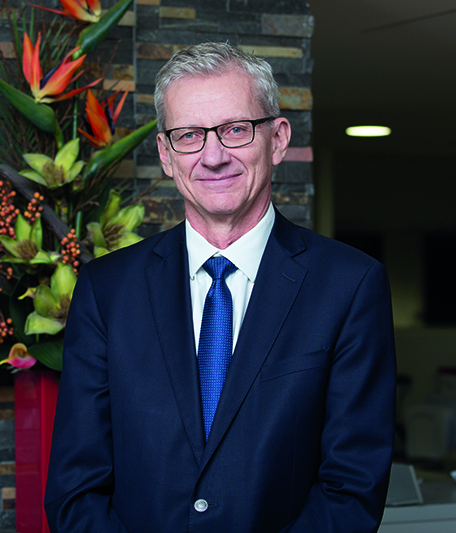 I am pleased to present to you the 2017–18 Australian Radiation Protection and Nuclear Safety Agency (ARPANSA) Annual Report.
I am pleased to present to you the 2017–18 Australian Radiation Protection and Nuclear Safety Agency (ARPANSA) Annual Report.ARPANSA continues to deliver high quality services and advice to the Australian Government and community on radiation protection and nuclear safety. Some of these services are delivered on an ongoing basis while others are based on new initiatives, such as review and assessment of major licence applications, new scientific information, or the specific needs of stakeholders.
In April 2018, I issued a licence to the Australian Nuclear Science and Technology Organisation (ANSTO) to operate the new ANSTO Nuclear Medicine Facility at the Lucas Heights Science and Technology Centre. This was the culmination of several years of review and assessment by ARPANSA staff through the different licensing stages: including siting, construction and operation. The operating licence allows ANSTO to commence ‘hot commissioning’ and extract molybdenum-99 from uranium target plates that have been irradiated in the OPAL research reactor. A number of licence conditions need to be satisfactorily addressed by ANSTO, before I can make a decision on whether to authorise ANSTO to move to routine production for national and international markets.
In the 2017–18 budget, ARPANSA received an equity injection of $5 million to install a new state-of-the-art medical linear accelerator. This will supplement and eventually replace the existing linear accelerator, which was installed at ARPANSA’s Melbourne laboratory almost ten years ago. The construction works for a new bunker have started and the supplier of the equipment has been selected. The new linear accelerator will support research and calibrations, and ensure continued delivery of ARPANSA’s auditing service for linear accelerators used by radiotherapy service providers in Australia. Almost all radiotherapy service providers in Australia have signed up to ARPANSA’s audit program. This represents a major contribution to the safety of patients undergoing cancer treatments using radiation.
We have also performed over 2700 diagnostic reference level surveys, which is an increase by almost 80 per cent from last year. Clinics use reference levels to benchmark their diagnostic procedures to ensure the radiation exposure of patients during medical imaging procedures is appropriately managed, while achieving the desired diagnostic outcome. This promotes good practice in diagnostic imaging — the largest contributor to radiation exposure of the Australian population.
Plans for a National Radioactive Waste Management Facility (NRWMF) are progressing under the Department of Industry, Innovation and Science. ARPANSA, as the independent regulator, is responsible for the licensing of any future NRWMF. During the year, ARPANSA continued its engagement with interested parties to explain the role of ARPANSA and the licencing process. While ARPANSA has no advocacy role in the establishment of a NRWMF, we contribute to the rigour and integrity of the process by providing early visibility of the regulator.
ARPANSA continues to promote radiation protection of workers and the public though our services. This year we processed close to 150 000 optically stimulated dosimeters that measure radiation exposures in occupational settings; tested over 2000 sun protective materials; and issued over 3.5 million ‘swing tags’ on consumer products, with information on their sun protection properties. The Australian National Radiation Dose Register, which holds dose records for uranium mining and milling workers, is now receiving dose records from ARPANSA’s licence holders and has also expanded into the medical sector.
We undertake significant international engagement, including with international organisations that carry out risk assessments and set standards. This year, ARPANSA led the Australian delegation to the 6th Review Meeting under the terms of the Joint Convention on the Safety of Spent Fuel Management and on the Safety of Radioactive Waste Management. Australia’s report went through a process of international peer-review and received positive feedback, including receiving recognition in four areas of ‘good performance’.
During the year, we performed a self-assessment in preparation for an IAEA Integrated Regulatory Review Service (IRRS) of the Australian system for radiation protection and nuclear safety. It is highly satisfying that all states and territories participate in the IRRS, making this the first international review of our national system for radiation protection and nuclear safety. The IRRS will culminate in November 2018 with a two-week mission to Australia. It will be comprised of 19 international experts, nominated and coordinated by the IAEA. The mission will verify the self-assessment and supporting material provided by ARPANSA and the states and territories. The findings and recommendations will be delivered in a report prepared by the mission and published on our website during the 2018–19 financial year.
As we move in to 2018–19, we will continue our NRWMF engagement activities and prepare ourselves for the review and assessment of a possible site licence application. We also look forward to commissioning the new linear accelerator during the year. We will continue to develop and enhance our systems, capabilities and assets to sustain and improve our services, and leverage our scientific and stakeholder networks to deliver radiation protection and nuclear safety to the Australian community.
Our dedicated staff will continue to demonstrate that we are Australia’s leading authority on radiation protection and nuclear safety.
Carl-Magnus Larsson
CEO of ARPANSA


